
***This is a paper I wrote back in 1999, so the info is recent as of then... ***
In the early twentieth century a genre was developed which was made up of pulp novels. Today, the same genre is a multi-million dollar part of our culture called science fiction.
With rapid social and technological changes taking place in this century science fiction has developed, coming from a history plagued with a sea of pulp novels to the present, where it is the most popular literary genre.
This past century has seen dramatic change in America and the rest of the world. Man learned how to fly and then sixty years later he was on the moon. The Earth has survived two grueling world wars and an atomic age which started only a few decades later. As a result of these and other advancements questions of morality and other social problems have arisen, and people are interested in these problems. As always people want to see the future and no other genre exploits this as science fiction does. Now today science fiction is more popular than ever before.
Science fiction is a type of fiction that is based on
either actual or imagined discoveries of science. It is
distinguished from other tales of fantasy or the supernatural
because science fiction is somewhat grounded in science and
has philosophical and sociological implications.
-Fracis R. Hart
Every type of science fiction has a motif of "What if...", "If only..." or "If this goes on..." and many include a combination of these. Science fiction is an excellent tool for investigating the results of human acts and inventions. Science fiction was actually created during a time of a lot of inventions and influential human acts in the industrial revolution.
Stories by Jules Verne were the first 'true' science fiction tales. They were written with an optimistic tone to them, with inventions such as the submarine in 20,000 Leagues Under the Sea. Man going to the center of the earth or traveling to the moon were common dreams of the mid-eighteen hundred's writers in this Age of Optimism. This could not last forever, though, and with the social problems caused by the Industrial Revolution it was only a matter of time before pessimistic views slipped back into society's mind frame.
At the turn of the twentieth century tension was building up to the first world war, creating a pessimistic world. H.G. Wells lead the procession of early twentieth century pessimism. Wells' books were concerned with such issues as Martians invading Earth in War of the Worlds and insane scientists manipulating life in The Island of Dr. Moreau. Another early 20th century pessimistic writer was Karl Capek, and he wrote R.U.R. (Rossum's Universal Robots) which was about mass production of robots which eventually bring an end to humanity. Once the first world war was over, though, people drifted back into being more optimistic, which helped spread a new breed of ideas.
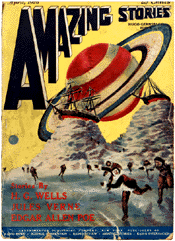
The 1920's held an air of Victorian times, and to these people speculative fiction and fantasy were very appealing. This time and fiction was affectionately called "Sense of Wonder."
Sense of wonder was a throwback to the basic appeal of
Speculative fiction that had been dominant before the Age of
Reason repressed the external expression of the internal human
landscape, and was an early forerunner of the new style of
consciousness that would come into full flower in the
1960s.
-Taken from Norman Spinrad's book, Modern Science Fiction
This Sense of Wonder lead to the publication of the first real science fiction magazine, Amazing Stories. This magazine was put out by Hugo Gernsback, who is often referred to as the father of the science fiction. Gernsback gave the genre its name and the first time for the public to get a hold of it. As a result this gave hungry writers a chance to redeem themselves. There were a large number of imitations made after the success of Amazing Stories and so another man came into the business, John W. Campbell. His magazine was called Astounding Stories, a successful imitation of Gernsback's classic magazine. It was Campbell's magazine that exploited the new possible themes such as robots, alternate worlds, faster than light travel, seeding of galaxies by humans and/or aliens and the consequences, and in the 1940s the whole range of topics presented by nuclear power. This time period from the 1930s to the 1940s became known as the pulp era. The sub-genre of 'Space Opera' was used to describe the literature published in that time. Each story would be an adventure where the hero in a space suit and cruiser would destroy alien worlds to save the universe and rescue the beautiful space maiden. It wasn't until the 1950s when readers began to realize the that all of the novels were poorly written space operas.
By the mid 1950s science fiction was finally gaining some respect by some of the more elite literary scholars. More people saw that science fiction was becoming science fact. Inventions such as the atomic and hydrogen bombs, transistors, compact electronic devices, pocket-sized radios, jet planes, and television were predicted in earlier 'pulp novels'. So, with rapid sales of televisions sales of fiction dwindled - except that of science fiction. At the time young writers didn't have a market for their stories, unless it was science fiction related. With the coming of the 1960s science fiction went under revolutionary change, this era was known as the New Wave. The stories were about ordinary people being influenced by science, and were not as scientifically correct as some of the previous science fiction works. This science fiction concerned itself more with sex and violence then with science. This New Wave created a stylistically more sophisticated and metaphoric type of science fiction different from the past.8 The Americans of this time were also going through a cultural revolution, writers had new ideas, thoughts, and inspiration from the evolving world around them and had grown up in a world of great scientific influence. The New Wave also drew more women science fiction writers in the field that had previously been dominated by men. These new women writers had a lot to contribute and today's science fiction has a lot to thank for from these first female pioneers. To see the roots of today's intense popularity look back to the technological aspects of the late to early eighteen and nineteen-hundreds.

When the end of the 19th century came, people were fascinated by the idea of aerial warfare. Jules Verne wrote a book entitled Clipper in the Clouds where a huge airship was made a huge advantage in a great war. This airship, the Albatross, was armed with cannons and guns, people called it a dangerous menace because it was capable of silent movement across country borders. Verne brought up the fact that if a city or military base was attacked by an airship like this then there would be no way for it to defend itself. In 1912 a writer by the name of Gustaf Janson wrote about what he thought the 1930s had in store for us.
The newspapers say Germany possesses 300 aircraft. They cross
the frontier at night and in the morning Paris is in ruins:
unexpected and without warning. Walls fall, people rush around
in panic, mad with terror; water mains and sewers--destroyed,
communications disrupted--chaos.
-Gustaf Janson
The dangers of aerial attack was the subject many writers addressed. H.G. Wells wrote The World Set Free and The War in the Air, both of which focused on aerial warfare. The latter predicted social collapse and political disorganization by the fictitious aircraft. These book's accurate battle methods actually caught the attention of a military lieutenant who invited Wells to a organizational meeting to discuss their military tactics with some of the best European strategists. Wells' The World Set Free, written in 1914, foresaw the development of the nuclear bomb. One quote from this book said :"This (bomb) would destroy city after city without mercy". These types of ideas seemed outrageous and sometimes horrific when they were written, but within 7 years man learned to fly tactically, and these stories were coming true.
The novels about war and attack strategies established many beliefs, some of which were very mistaken. People felt that any civilized nation would not kill and destroy a whole city filled with civilians. Another idea was that even if a city was not completely destroyed by one of these bombs the city would destroy itself with all the panic and chaos following it. Science fiction was not only impacting the bad side of life though.
Magic had re-entered the world through science fiction and
technology, and the only real literary expression of the
drastic reorientation of human consciousness was the genre
of science fiction.
-Norman Spinrad
With rapid technological growth this century everything that we do is controlled by it somehow. The airplanes, automobiles, radios, televisions, and color photography, were all important developments this century. For the first time people could drive around in personal vehicles without having to bother with caring for animals to pull them. Radios were made and perfected so the relay of information was quicker--and for the first time it was possible to speak to the whole country at once. With the invention of the television several years later, people could actually watch national and international events in their own home. Television also gave people entertainment and a new and more exciting way to learn about the world around them. With this rapid growth it was easy to see how many people lost track of how everything works--in this way science fiction writers and creators to be able to play off of people's fears.
People feel crushed by government, abused by corporate
employers, and baffled by computers. Technology is moving fast
forward and we rarely get a chance to understand the
implications. Most of us can't even program our own VCR. We
the tools of science in our hands and we are afraid of them.
-Chris Carter
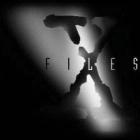
This comes from the popular science fiction director Chris Carter. Science fiction along with government conspiracies have made these types of shows popular. By using science fiction, writers can take the fears of things people don't understand and scare them.
In another angle, it is possible to see with all of the new inventions being developed that people have more free time. Within just the past 30 years movie theaters have grown immensely in popularity. Many of the movies today deal with ideas of social corruption and aliens. In 1947, in Roswell, New Mexico a craft fell from the sky and many people thought that it contained alien bodies and alien technology. People say that all of the remains were taken to a secret, remote military base known as Area 51. Since then movies such as Independence Day and The Rock have had a guest appearance of the secret base. The public has taken their love of science fiction to comical lengths in this subject. This sparked an off-the-wall comment by comedian Kevin Murphy (voice of Tom Servo on Mystery Science Theater 3000):
Or how about this? All of those socks from all those dryers
get sucked through your dryer vents into a porthole, and they
end up in Area 51. The government scrapes some of the DNA off
the socks and gets a genetic encoding. Then it puts it all in
a huge computer so it can always know what you are doing.
-Kevin Murphy
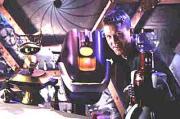
It is easy to derive from this example that science fiction is mostly about current problems and how people react to them.
(Science fiction is) a realistic view of the present. I don't
think of myself as a futurist. I think I am someone who
inhabits a baffling, and in many cases, terrifying present.
Science fiction is about the year in which it is written.
-William Gibson
This was written by science fiction writer William Gibson who's idea, is shared among many if the most important writers in history. The publisher of Astounding Stories, John Campbell agrees with this by saying: "(Science fiction) is a form of literature that creditably shows the effects of technology and scientific advance on individuals, culture, and society."
In the 1930s many of the science fiction tales dealt with the energy crunch, overpopulation, mutations, and the new medical technique of organ transplanting. Then uranium fission was discovered, which prompted stories about atomic bombs and the effects we.
During 1950s people began dreaming about the possibility of creating androids and their relationships to humans, or about corrupt societies ruled by dictators. Many also wrote of the inevitability of technological holocaust where man would be destroyed by their inventions. This was all due to the dreams by many futurists of androids performing the necessities of life while people enjoyed life. Then there were those people who were afraid of the last world war resulting in the stories of corruption and dictators. The public was afraid that a dictator such as Hitler could rise again and have the ability to crush the entire world. Then as the 1960s came thoughts changed and turned to issues such as altered perception due to drug use.
Science fiction in the 1960s was influenced by sex, violence, experimentation, and many of the people in that time held a mood of deep pessimism. These were all characteristics of the time in which these people lived. They were fearful because of the Vietnam War and looked to themselves for restraint, comfort, and love. People also thought that the government was harsh and controlling and felt that they should have to go to war for a cause they didn't believe in. This is one of the issues addressed by Frank Herbert in Dune one of the most well-known science fiction books.
We are locked into forms, of government, of belief and
behavior which dooms us to keep repeating ourselves...
That's one of the points I wanted to make in Dune.
-Frank Herbert'
Dune dealt with free will and destiny and social control, all of which were fears and dreams of the people when Dune was published in 1965. It also touched upon the relationship between man, technology, and the environment, an issue that came out after the 1960s.
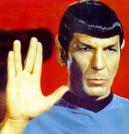
Philip K. Dick, was another science fiction writer in the 1960s, but his books dealt with the ability to distinguish between reality and illusion. In The Three Stigmata of Palmer Eldrich, the main character argues against the use of drugs in the Mars space colony. In his book A Scanner Darkly hallucinogenic drugs are the main subject and it has a character who condemns drugs, saying they damage the mind by distorting natural perception.It is important to note that at this time hallucinogenic drugs were being experimented with and many people died as a result. By writing these books Dick was trying to make an open statement about these drugs and the manner in which the nation's children had been acting. Thoughts like that of the 1960s carried through the 1970s, leading up to another science fiction change.
During the 1980s science fiction attacked many writers
who used their considerable knowledge (particularly in the
behavioral sciences) to inspire their speculations.
Ursula K LeGuin was one of these writers, she used her sociological theories as starting points of her science fiction tales. She tried to understand society and the way people for her intriguing novels. Ian Watson was another writer who used non-fiction in his stories. Watson took on the social sciences and cosmetology in his works, to explain world or worlds that he visited in his books. Watson was later ranked one of the most important and influential science fiction writers of his time, and he closed the 1980s science fiction era.
In this post-Cold War era it seems that people are looking to outer space for their enemies.
The communists were the enemy, before them the Nazis, now our
wonderful enemy has been lost. Aliens give us a terrifying
enemy that's politically correct.
-Director Paul Veroeven
These aliens now in films such as Men in Black and Independence Day represent our non-existing enemy, or enemies that are not politically correct to have. Much like the aliens in the 1950s represented the communists - invaders who intended to wipe out our cultural history - these aliens are dangerous enemies that we need to be fearful of.
It seems that science fiction concerns itself with beings from other worlds in the future, but it is really about things today.
Science fiction is a form of literature that takes place in an
alternate present, a reconcieved past, or the extremely
advanced future. All of those alterations in time or reality
are based upon technological or sociological changes in the
observed, realistic now.
The subject of change in this past century has been experienced we know more, faster.
The foremost reality that science fiction deals with is
change, which could be the reason for the growing interest
in the twentieth century, when the world has experienced more
change than ever before.
-Fredrik Pohl
Science fiction was 'created' in the early twentieth century as a literary response to a new curiosity that did not exist in all of man's early history. Before the industrial revolution great inventions were at such intervals that it was not possible for one man to see much change during his lifetime. As soon as the industrial revolution came, though, it became possible to see great changes in one man's life.

In the early 20th century, technology and all of human knowledge was growing faster and faster, and science fiction changed also. Writers began to explore new avenues and everything was probed for the possibility of being a new revelation in human history.
1945 marked a milestone in human history, this gave birth to the United Nations, The Cold War, and the Atomic Age was upon us. In addition to the fact that for the first time in human history man held the ultimate power of life and death for the planet. So much had been accomplished that it would be hard to comprehend it all of looking from one-hundred years ago. Who would have guessed that we would be on the moon in the 1960s? The answer, many writers did. Writers molded speculative fiction in a way that dealt with modern reality. About the continual metamorphosis of human consciousness.
Humans are ever-changing and even a superstitious species, and we need to look outside ourselves for something and this is what science fiction does for people. We are interested in many things that are beyond our grasp, that's why we find science fiction intriguing.
In another way, we are interested in knowledge as a result of living in a science-worshipping society.Where someone's God or gods fail them in their supernatural sub-consciousness they look toward more earthy and 'reasonable' outlooks. Science fiction is an all-telling deity for many people, where fears and thoughts of the future can be relayed.
When magazine writer Hugo Gernsback was young, he would tell his mother and friends about what he thought the future held. When Gernsback became a writer and magazine creator his thoughts of the future never left him. His tales were filled with ideas as robot doctors, retirement colonies on Mars, and domed cities orbiting the Earth. In 1926 and the years following he dreamed about the possibility of having television, by publishing the first TV magazine ever. On the cover of one of these magazines he had a picture of a family sitting in the living room enjoying a televised sport, because Gernsback felt that sports would glue viewers to the screen. In 1929 Gernsback had ideas about sending radio waves to the moon predicting it would take 2.4 seconds, and then less than twenty years later, the scientific community accomplished that and the time it took was only one-tenth of a second off of Gernsback's prediction. Micro fiche, skywriting, tape recorders, solar power, holograms, fax machines, and even tethered space walks were predicted by Hugo Gernsback. The concept of radar was actually conceived by Gernsback, and the inventor even credit's Gernsback for part of the idea. In 1929 Gernsback spoke about an orbiting satellite, then in 1957 the first was launched, in much the same matter as predicted by him.
Gernsback was not the only person to predict satellites. World renowned author Arthur C. Clark, who has his bachelors degree in both physics and math, predicted communication satellites. In 1945 Clark described in an interview communication satellites, and in 1965 the first of such satellites was launched. Even today Clark is considered the Godfather of the communication satellite. Clark also went into the field of computers in one of the most famous science fiction novels of all times, 2001: A Space Odyssey. In this novel there is an all-controlling computer named HAL 9000 who goes mad, this future thinking helped researchers develop speech recognition for non-fictitious speaking computers.
Other predictions about the computer have surfaced also. In 1981 a writer named William Gibson wrote a book called Burning Chrome which spoke of a electronic network that brought people together. In this book Gibson coined the word 'cyberspace' a word that is used as a name for the internet that we have today. Later works of various writers created the 'Cyberpunk,' who was a hero 'whose richest resources live within he computer." All of these predictions, and countless others made science fiction more fun and inspiring to it's fans. People would give almost anything to see the future, and science fiction offers that.
Today science fiction is one of the most popular genre in American society. Films such as Independence Day and Men in Black have grossed hundreds of millions of dollars from ticket sales and such. The twenty year old Star Wars Trilogy has made their stars and creators international figures, and since the first was released they have brought in money continuously. Star Wars characters have also been on the cover of hundreds of magazines since their release of the films, and collectors around the world have tried to collect memorabilia from the films. Even now Star Wars has great influence in advertising, people will buy the product if it's a collector's item. Television has also been an excellent medium for modern science fiction.
Television programs such as the X-Files have also risen to exceptional heights. The X-Files, on its fifth season, has gained millions of viewers across the country. The stars of the X-Files see their pictures on countless magazines and merchandise, and the show even has it's own magazine. Television has been an excellent channel for science fiction to be expressed. The new Sci-Fi channel is a good example of a modern science popularity. By the increase of popularity in science fiction it can be seen how the visual medium of television and film has shaped the genre.
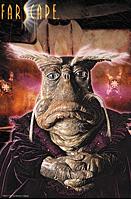
There are many events that helped shape and mold science fiction and people's attitude toward it. As humans we are curious about the unknown times and worlds, and we even enjoy creatively understanding a bit about the society we live in. Now today people are enthralled by science fiction and curious about the topics discussed in it. Interest in science fiction was made throughout a century of revolutionary change. We are drawn to science fiction now more than ever before because of the entertainment value and more importantly offers a way for us to view the past, present, and future like no other type of fiction can.
People are intrigued by science fiction and drawn to it because of its strange plot changes and the foreign environments. Without this visual medium we would be swamped by our technology advances that seem distant because of the speed at which it travels. We can learn and understand science and its implications by reading of watching science fiction, and we maybe even learn a little about ourselves.
Bibliography
Asimov, Isaac. Asimov On Science Fiction. New York: Doubleday and Company Inc., 1981.
Corliss, Richard. " The Invasion Has Begun!" Time, July 8, 1996, pp. 58-64.
Hart, Francis R. "Science Fiction" Merit Student's Encyclopedia, 1988 ed.
Krantz, Michael. "The Literature of Nerds Goes Mainstream." Time, July 8, 1996, pp. 62-63.
Marxaim, J. D., ed. 1979 Dictionary of Science Fiction. New York: Doubleday, 1979.
Moukneiber, Zina. "The Greeks Have Inherited the Earth." Forbes, July 7,1997, pp. 348-362.
Paris, Michael. "Fear of Flying the Fiction of war." History Today, June 1993, p.p. 29-35.
Pohl, Frederik. "Science Fiction: Stepchild of Science." Technology Review, October 1994, pp. 57-61.
"Science Fiction." Grolier Electronic Publishing, inc. 1993 ed.
Spinrad, Norman, Modern Science Fiction. New York: Anchor Press/Doubleday, 1974.
Stashower, Daniel. "A Dreamer Who Made us Fall in Love with the Future." Smithsonian, August 1990, pp. 44-55.
Sturgeon, Theodore. "Science Fiction," Encyclopedia America, 1992 ed.
Walker, Marshall. The Literature of the United States of America. London: Marshall Walker, 1988.